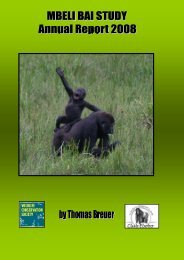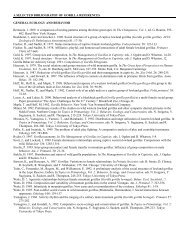First Prosimian Husbandry Workshop 2009 - Cleveland Metroparks ...
First Prosimian Husbandry Workshop 2009 - Cleveland Metroparks ...
First Prosimian Husbandry Workshop 2009 - Cleveland Metroparks ...
You also want an ePaper? Increase the reach of your titles
YUMPU automatically turns print PDFs into web optimized ePapers that Google loves.
We do not know if Vitamin C contributes to the development of hemosiderosis, however studies in<br />
humans seem to indicate that it is not a huge issue. Anemia is a large problem in humans,<br />
especially women. If people are fed iron in conjunction with vitamin C, it helps to absorption of<br />
digestion. If you are not iron deficient and you add vitamin C, it lowers absorption of iron.<br />
Vitamin C should not be a huge concern in diets.<br />
Comment (Karen Weisenseel) They do not even metabolize vitamin C.<br />
Some species of lemurs process iron differently than others, ruffed lemurs store iron the most.<br />
They have never seen hemosiderosis in insectivorous or foliviorous animals.<br />
Animals if they are fed appropriately should not be given supplements and never iron supplements.<br />
Question (Jacqueline Broder) Is a mineral salt lick ok?<br />
Moderator (Cathy Williams): Yes, as far as we know this is fine.<br />
Question: (Scott Gamerl) Is there an effect when feeding different types of oak?<br />
Moderator (Cathy Williams): All types of tannins bind iron even though there are different types of<br />
tannins in different types of oak.<br />
Question (Monica Mogilewsky) Has anyone located low-iron infant formula?<br />
Answer (Chris Kuhar) Preemie formula.<br />
Answer: Also, low-iron infamil and Neosure can be fed.<br />
Hand-rearing vs. supplementation<br />
Refer to chapter on CD<br />
It is important to go to great lengths to not hand-raise a lemur. Aside from general hand-rearing<br />
issues, we do not have good formulas. Hand-rearing is different from supplementing, where the<br />
individual is still with the mother. Hand-rearing leads to a potentially nutritionally deprived<br />
individual. Growth curves are much lower in hand-reared individuals and are not getting as much<br />
contact. This does not mean they don’t need help with nutritional or medical support. Even when<br />
mother is not producing enough milk, the individual can be pulled and given milk, but can still<br />
learn behavior from the mother.<br />
Question (Julie Taylor) What about oxytocin and lactation?<br />
Moderator (Cathy Williams): We will pull infants and put in incubator or restrain mothers, but<br />
only for so long. We are not opposed to knocking down a female and putting the baby on her. To<br />
help lactation, oxytocin can increase uterine contractions and help milk let-down. It also is a<br />
feedback loop to the brain to produce more milk. Also, can use metaproclamide (Reglin).<br />
Question: What is the dosage?<br />
Moderator (Cathy Williams): Not sure, given three times a day.<br />
Comment (Julie Taylor) Also, important to remember there may be other reasons a mother is not<br />
lactating.<br />
Question: Does it work in other species?<br />
Moderator (Cathy Williams): Yes.<br />
Question (Kristen Lukas): What about fenugreek?<br />
Moderator (Cathy Williams): I don’t know much about it. It works well in human females.<br />
Answer (Julie Taylor): We tried this briefly, but she didn’t like it.<br />
13




